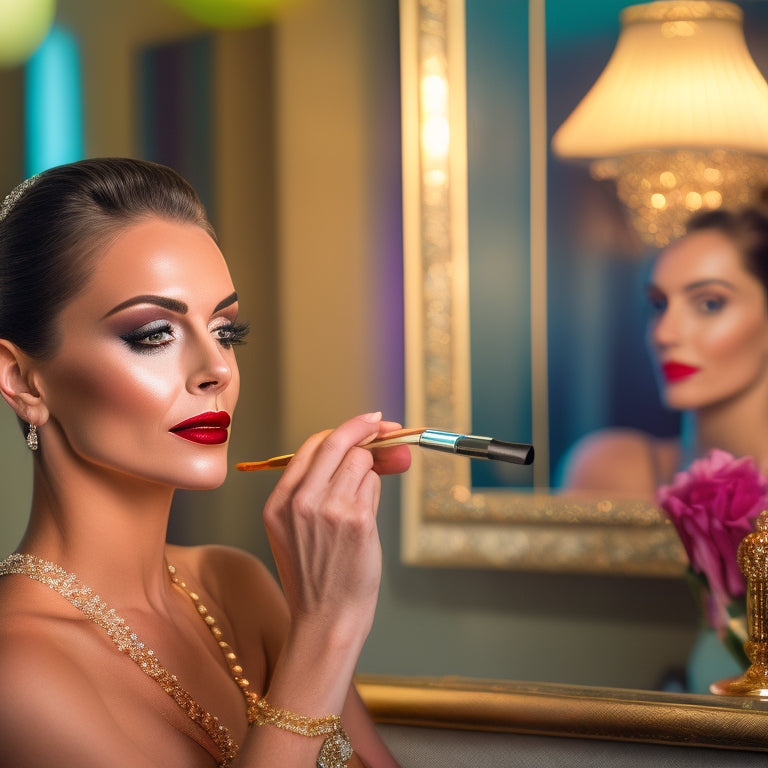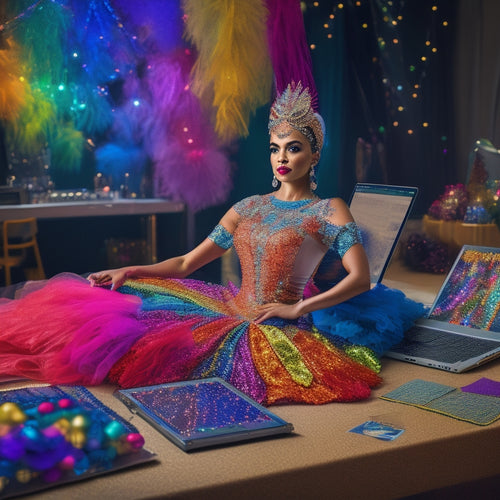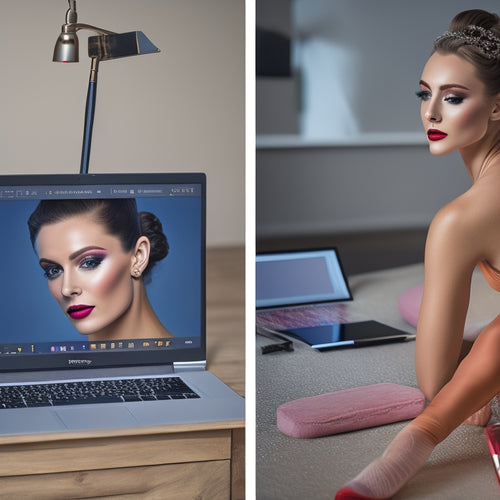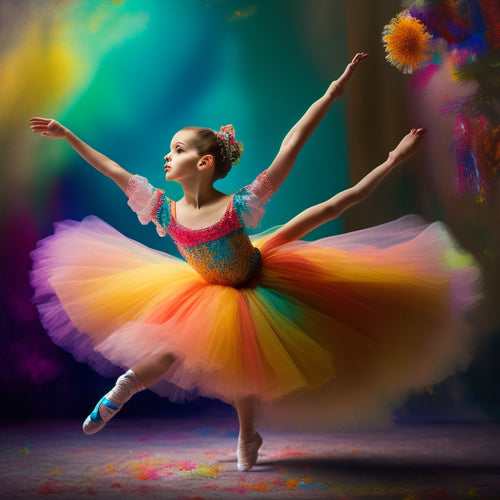
What Makes Ballroom Dance Makeup Tutorials So Effective?
Share
You're about to discover the magic behind effective ballroom dance makeup tutorials. It all starts with a cinematic aesthetic, where visuals evoke emotions like sophistication and passion. Personalized instructions cater to individual dancers' skin types and facial structures, ensuring a flawless, camera-ready look. Step-by-step guides break down the application process, accompanied by clear visuals and product tips. Strategic lighting accentuates features, and a confident on-camera presence is developed through practice and posture. With these elements in place, you're just a step away from revealing the secrets to mesmerizing ballroom dance makeup tutorials that truly captivate.
Key Takeaways
• Cinematic aesthetics and immersive world-building captivate audiences and transport them to the world of ballroom dance.
• Personalized makeup tutorials tailored to individual dancers' skin types, facial structures, and style preferences foster a sense of ownership and confidence.
• Step-by-step guides with clear descriptions, close-up photos, and videos empower dancers to master makeup techniques and achieve a flawless look.
• Effective lighting that accentuates features and conceals imperfections creates a professional and polished visual appeal.
• Mastery of facial expressions, body language, and camera presence enables tutors to exude confidence and authority, engaging audiences and conveying expertise.
Engaging Visual Storytelling Techniques
As you prepare to create enchanting ballroom dance makeup tutorials, masterful visual storytelling techniques become essential, allowing you to weave a narrative that transports your audience into the world of elegant waltzes and dramatic tangoes.
To craft a compelling story, you'll need to develop a cinematic aesthetic that immerses your viewers in the world of ballroom dance. Start by creating a mood board, a visual representation of your desired aesthetic. This will help you define the color palette, lighting, and overall tone of your tutorials.
Consider the emotions you want to evoke in your audience - sophistication, passion, or romance - and choose visuals that evoke those feelings. As you begin filming, pay attention to framing, camera angles, and movement. Use close-ups to highlight specific makeup techniques, and wide shots to showcase the dancer's movements.
Personalized Instructions for Dancers
You'll want to tailor your makeup tutorials to cater to individual dancers' needs, taking into account skin types, facial structures, and personal preferences to guarantee a flawless, camera-ready look that complements their unique style.
By considering these factors, you'll create personalized instructions that resonate with each dancer, enhancing their overall dance persona.
When developing a makeup routine, consider the dancer's skin type - will they require a specific foundation or concealer to combat oily or dry skin? Are there any facial features they'd like to accentuate or minimize? What's their personal style - classic, elegant, or bold and dramatic?
Understanding their preferences will help you craft a customized look that not only complements their dance style but also boosts their confidence.
Step-by-Step Makeup Guides
Create a step-by-step makeup guide that breaks down the application process into manageable, easy-to-follow sections, allowing dancers to replicate the look with precision and confidence. As you create your guide, make sure to include detailed descriptions of each step, accompanied by clear, close-up photos or videos. This will help dancers visualize the process and make sure they're applying their makeup correctly.
Organize your guide into sections, such as 'Preparation,' 'Foundation,' 'Eyes,' and 'Finishing Touches.' This will help dancers navigate the guide easily and focus on one area at a time.
Be sure to highlight essential makeup products, like foundation, eyeshadow, and mascara, and provide tips on how to choose the right shades for their skin tone.
Consider offering a Virtual Try On feature, allowing dancers to see how different products would look on them without having to physically apply them.
Effective Use of Lighting
When applying makeup for ballroom dance competitions, strategically positioning light sources can accentuate your best features and conceal imperfections, making it essential to master the art of lighting.
As you prepare for your tutorial, remember that soft, diffused light is your best friend. Invest in a softbox or a ring light to create a flattering, shadow-free zone around your face. This will help highlight your best features and reduce the appearance of blemishes.
To create a natural ambiance, position your light sources at a 45-degree angle to your face, slightly above eye level. This will mimic the soft, gentle light of natural daylight, making your skin tone look radiant and even.
By controlling the lighting, you'll be able to showcase your makeup skills and create a stunning, competition-worthy look. Remember, the key to effective lighting is subtlety – aim for a soft, gentle glow that enhances your features without overpowering them.
With practice, you'll discover the secrets of softbox lighting and create a flawless, camera-ready look that will dazzle the judges.
Building Confidence on Camera
Every competitor knows that confidence on camera is key, and it starts with mastering the subtleties of facial expressions and body language. You can't fake it – your audience will pick up on any nervous energy or discomfort. To build confidence, focus on developing your camera presence. This means being mindful of your posture, making deliberate gestures, and engaging with your audience through direct eye contact.
Remember, it's not about being perfect, but about being authentic and genuine. As you become more comfortable in front of the camera, you'll start to embody self-expression, and your audience will respond positively to your energy.
To take your confidence to the next level, practice your tutorials in front of a mirror or record yourself. Analyze your body language, facial expressions, and tone of voice. Identify areas that need improvement and work on refining them. With time and practice, you'll develop a sense of ease and authority on camera, allowing you to focus on sharing your expertise and passion for ballroom dance makeup with your audience.
Adapting to Different Skin Tones
You'll need to develop a keen understanding of how to adapt your ballroom dance makeup tutorials to accommodate various skin tones, from porcelain doll complexions to rich, dark skin. This is essential, as a one-size-fits-all approach won't cut it when it comes to foundation shades. You'll need to take into account the unique characteristics of each skin tone, including undertones.
| Skin Tone | Foundation Shades |
|---|---|
| Fair | Pink undertones: Look for foundations with blue or pink undertones to cancel out redness. |
| Medium | Neutral undertones: Balance warm and cool undertones with a neutral foundation. |
| Dark | Yellow undertones: Warm-toned foundations will help to enhance natural glow. |
Frequently Asked Questions
What Camera Equipment Do Ballroom Dance Makeup Artists Typically Use?
When capturing ballroom dance makeup tutorials, you'll need essential lighting equipment like softbox lights or ring lights, and a camera with interchangeable lens options, such as a 50mm or 85mm prime lens, to achieve professional, high-quality visuals.
How Do I Edit My Makeup Tutorial Videos for Better Engagement?
To edit your makeup tutorial videos for better engagement, you'll refine color correction, enhance sound design, and adjust video pacing to captivate viewers, then create eye-catching thumbnails that draw them in, ultimately boosting audience engagement.
Can I Monetize My Ballroom Dance Makeup Tutorials on Youtube?
"You can monetize your ballroom dance makeup tutorials on YouTube, where 62% of beauty YouTubers earn from ad revenue; focus on building brand recognition, boosting audience engagement, and leveraging affiliate marketing, sponsorship deals, and product placement to maximize earnings."
What Are Some Popular Music Genres for Ballroom Dance Makeup Tutorials?
When creating ballroom dance makeup tutorials, you'll want to sync your visuals with genres like Latin Groove, Funky Beats, Disco Fever, Rhythmic Waves, and Soulful Vibes to energize your audience and elevate your artistry.
How Often Should I Post New Ballroom Dance Makeup Tutorials Online?
As you plan your ballroom dance makeup tutorials, consider posting new content 2-3 times a week to maintain audience engagement. Create a content calendar to schedule and organize your tutorials, ensuring consistency and maximizing viewer interest.
Related Posts
-

Design Stunning Dance Costumes With Online Tutorials
With online tutorials, you're just a click away from accessing stunning dance costumes that mesmerize the audience. D...
-

10 Online Makeup Tutorials for Ballet Dancers
You're about to discover a range of makeup techniques specifically designed to enhance your ballet performances, from...
-

Artistic Fusion: Lerma's Little Dancer Triumphs
As I reflect on my artistic journey, I'm struck by the profound evolution that has occurred, marked by the triumphant...


